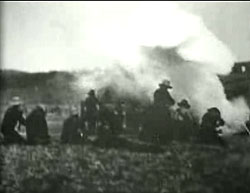 Viewed from behind, Boer gunners on knees are in an open field firing their rifles in Capture of Boer Battery (1900).
Viewed from behind, Boer gunners on knees are in an open field firing their rifles in Capture of Boer Battery (1900).
A cannon spews an enormous amount of smoke. Some of the men stand up so as to be better targets, but no one falls, as if we needed any further clues that this is a re-enactment.
Suddenly kilted Scottish soldiers afoot or on horse run at the Boer gunners & finally some men fall in the battle. The Gordon Highlanders are victorious!
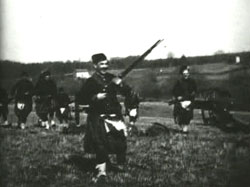 At a minute & a half, Capture of Boar Battery by British (1900) repeats the same reenactment. At a minute & a half, Capture of Boar Battery by British (1900) repeats the same reenactment.
It was rare that films from this era had two takes, but possibly because of the accident with the cannon's malfunction, pretty much the same film was made again.
Yet another Boer War episode was also provided with two nearly identical versions (the two Capture films reviewed below), so the thought must have been merely to extend the life of their marketability.
Films struck for sale to exhibitors were soon warn out & then needed either to be removed from catalogs, or a remake replaced the original. Such remakes were generally made a couple years later after a given film proved its popularity & the first negative scratched & worn, so the standard method was a little different for the Boer War films.
The second version starts with the same scene of kneeling Dutch Boers firing at Gordon's Highlanders. As the Highlanders close in, the Boers leap up & beat a fast retreat, kilted soldiers in fast pursuit.
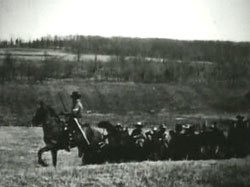 A mite over a minute's length, Boers Bringing in British Prisoners (1900) shows Boer captives from among the Gordon Highlanders, the British lancers, & the Irish Fusillers. A mite over a minute's length, Boers Bringing in British Prisoners (1900) shows Boer captives from among the Gordon Highlanders, the British lancers, & the Irish Fusillers.
It begins with a distant view of soldiers & horses, on the by-now familiar plain beyond which are hills, the filming location being rather too finite, so that the Boer War films collectively convey a sense that the entire of the war was fought on grampa's back forty.
There's a certain sad majesty when the mounted guard leads the captives in parade past the camera's eyes. The fault with James White's primitive "war films" is we never see striking faces or emotion or get any character out of the players. Yet here, by their woebegone postures, it's obvious the re-enacters are putting more into it than White finds easily filmed.
The majority of the mounted Boers are behind the walking captives. The re-enactors in general pretend never to notice the presence of the camera, but the very last Boer player to pass the camera lifts his hat & waves to the camera.
These & additional films on the topic of the Boar War weren't shot in South Africa, of course, but in the Orange Mountains of West Orange, New Jersey.
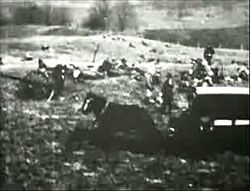 Another concocted scene from the Boer War, Red Cross Ambulance on the Battlefield (1900) is a bit shy of a minute & three-quarters. Another concocted scene from the Boer War, Red Cross Ambulance on the Battlefield (1900) is a bit shy of a minute & three-quarters.
Considering that the British conducted trench warfare at this time, the scene is not realistic, & is probably more influenced by the Civil War photography of Mathew Brady.
It's hard to know whether to categorize such films are historical fiction or as documentary newsreels, since they are halfway between, with recent incidents re-imagined by filmmakers who weren't even witnesses to the events. They purported in their day to be historically correct reenactments. But the Library of Congress is likely correct to have categorized them as dramas.
Soldiers mill about the wounded waiting for the return of the ambulence, which drives into the scene, as a mounted soldier rides slowly into the remnant of battle. There seem to be ambulance corpe members in hats larger than those of the soldiers, but they are not ministering to anyone.
Members of the ambulance corpe bring out a white stretcher for a man who can by no means stand, while others brace the wounded to help them hobble to the ambulance.
The horse-drawn ambulence then leaves the site of the battlefield fully loaded but with many men waiting to be transported & assisted. The film is poorly preserved, but at the tail end of the film it appears that in the lower left hand corner a man appears wearing what might be a hassock, evidently a priest for purposes of last rites.
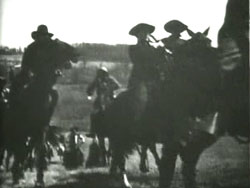 The Edision company had employed about 200 men, mostly members of the Orange militia, to re-enact these scenes. Half the men played Boers, the rest were in a multitude of English, Irish & Scottish costumes.
The Edision company had employed about 200 men, mostly members of the Orange militia, to re-enact these scenes. Half the men played Boers, the rest were in a multitude of English, Irish & Scottish costumes.
They were initially hired for $2 a day, but the clever chaps formed an impromptu union & refused to perform until promised $2.75.
The location was not very distant from the Livingston Line commuter rail, so it was not difficult to get the large cast, equipment, cannons, guns, & such, to the location.
A nearly identical pair of films resembling the two Capture of of Boer Battery strips, but reversing the point of view, were filmed at the same location. They are Charge of the Boer Cavalry No. 1 and Charge of the Boer Cavalry No. 2 (1900).
For these, mounted solidiers dominate, & the specific encounter the filmmakers had in mind was the Battle of Spion Kop, named for its location near & on a hilltop in Natal, South Africa, along the Tugela River.
The battle was one of the worst defeats for the British during the Anglo-Boer War. It had occured on the 23rd & 24th of January, 1900, so was very contemporary news as White was filming.
No. 1 is a half-minute that opens on a nearly empty plain, hills in the greater distance. Very small on the plain are men & horses, Boer cavalry as it turns out.
The mounted Dutch rush forward into greater view, eventually obscuring the camera, they're so near. We never see who they are after, but we can imagine it's still the battle with the Gordon Highlanders.
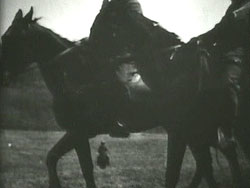 No. 2 is again a half-minute, & pretty much the same shot done again. Mounted Boers gallop forth from a great distance, to within a few feet of the camera. No. 2 is again a half-minute, & pretty much the same shot done again. Mounted Boers gallop forth from a great distance, to within a few feet of the camera.
We first see a group of Boer gunners in chaotic formation, gathered more or less around their national flag. In the distance horses appear, & the British lancers are on their way, without regard for Boer cannons.
In the general melee of the encounter, the Boer flag can be seen upheld amidst smoke from cannon & guns.
It was during the filming of the Spion Kop scene that a cannon misfired. There were no cannonballs involved, of course, but the cotton wadding fully aflame flew out of the cannon & struck James White & one of his men. The other man had only minor injury, but White had to be transported by train to hospital.
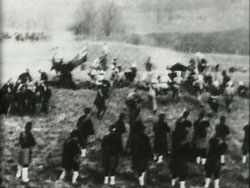 In a few days White returned to the location to finish the Boer War film series, but was still suffering from severe burns.
In a few days White returned to the location to finish the Boer War film series, but was still suffering from severe burns.
He brought with him as assistant Mason Mitchell, an actor who pretty much took over the action direction to ease White's burden.
During the Spanish-American War, Mitchell had also been one of Teddy Roosevelt's Rough Riders; so he was the perfect assistant for war re-enactments.
Besides the post-battle sequences with the ambulence & with the British captives, Mitchel orchestrated the action for Battle of Mafeking (1900). This recreates moments of an encounter between Highlander footsoldiers & Boer cavalry, at about a minute & a quarter.
Mafeking, in the Natal Colony, was held siege from October 1899 to May 1900. When Robert Baden-Powell turned the tide of the war & ended the siege, he became an international hero, just the chap to afterward establish the Boy Scouts in the UK. Mafeking was aferward a symbol of the hard-won victory over the Boers, & a natural subject to attract film viewers of the era.
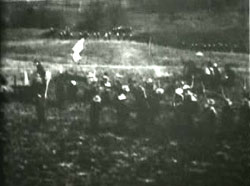 Another lively piece is English Lancers Charging; aka, British Lancers Charging at Modder River (1900). It's a bit longer than most in this series, though still only about a minute & a half. Another lively piece is English Lancers Charging; aka, British Lancers Charging at Modder River (1900). It's a bit longer than most in this series, though still only about a minute & a half.
Boer foot soldiers have taken a stand, firing on lancers in the distance, their flag displayed in their midst.
Smoke obscures the scene, & as it clears a bit, we see the lancers on horseback closing fast, their own flag to the fore, until the British flagbearer falls in battle.
There's a melee as the two forces clash, until surprisingly the Brits begin to retreat, & the Boers are waving their flag back & forth obviously hooping for the joy of victory, though the odds had been so against them.
The Battle of Modder River occured by the bo0rder of the Orange Free State northwest of Cape Colony, & was indeed one of the unexpected defeats for the well-organized but predictable Brits against the ragtag but deeply entrenched Afrikaaners.
What the film doesn't show is that the Boers actually outnumbered the Brits at Modder River. Their victory, however, was painfully won at great loss, & they would never again fight with superior numbers.
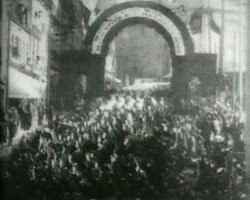 Though White's war films are fake, he'd earlier headed up to Quebec & filmed the actual 2nd Special Service Battalion, Canadian Infantry -- Parade (1899), immediately prior to their heading off to South Africa.
Though White's war films are fake, he'd earlier headed up to Quebec & filmed the actual 2nd Special Service Battalion, Canadian Infantry -- Parade (1899), immediately prior to their heading off to South Africa.
It begins with a momentary shot of the street before the parade began, showing a streetcar going under a triumphal arch, & moderate downtown activity.
It then flickers & cuts to later in the day, with the street absolutely packed with thousands of parade onlookers, waving flags in a patriotic frame of mind, eager as everyone was at that time to kill plenty of Afrikaaners for disrespecting British laborers & farmers in Transvaal.
Parade-goers mill about on the streetcar tracks, all over the street & sidewalks. They soon cluster onto either sidewalk area, as the 2nd Special Service Battalion marches down the street, toward the camera. It appears as though a few civillian men in smart suits are marching uninvited & in disorderly manner ahead of the orderly soldiers.
The rest of this one-minute film is taken up by the marching, marching, marching of men in dress uniforms. The street's grand arch lends the compositon a certain elegance.
A contemporary catalog discription asserts the film next shows the men marching on a wharf, preparing to board the "Sardinian," but this scene is absent & may well never have been attached.
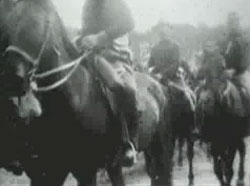 In New Zealand, Alfred Henry Whitehouse had a somewhat similar idea for a film. With his Edison Manufacturing equipment he shot The Departure of the Second Contingent for the Boer War (1900) which is the earliest surviving film made in New Zealand. In New Zealand, Alfred Henry Whitehouse had a somewhat similar idea for a film. With his Edison Manufacturing equipment he shot The Departure of the Second Contingent for the Boer War (1900) which is the earliest surviving film made in New Zealand.
He made ten films that year & used them to try for government funding for his company. When he could not induce interest, he gave up his project, & gave up filmmaking altogether.
Only this one film among his works survives, though he'd been exhibiting films since 1895, qualifying him as one of the earliest of the early pioneers.
If James White's films from the same period are the comparison, then by the evidence of his sole surviving film, Whitehouse was as good or better than any. It's essentially a parade of men on horseback passing before the camera lens, very nice basic composition.
The parading cavalry are very numerous, but as we see them rounding an imaginary corner, I can't help but wonder if they weren't parading in circle so that we see some of the same riders more than once.
copyright © by Paghat the Ratgirl
|
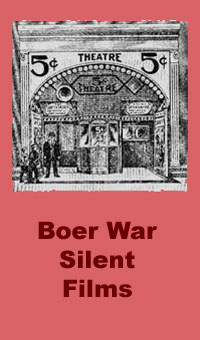

 At a minute & a half, Capture of Boar Battery by British (1900) repeats the same reenactment.
At a minute & a half, Capture of Boar Battery by British (1900) repeats the same reenactment.
 Another concocted scene from the Boer War, Red Cross Ambulance on the Battlefield (1900) is a bit shy of a minute & three-quarters.
Another concocted scene from the Boer War, Red Cross Ambulance on the Battlefield (1900) is a bit shy of a minute & three-quarters.
 No. 2 is again a half-minute, & pretty much the same shot done again. Mounted Boers gallop forth from a great distance, to within a few feet of the camera.
No. 2 is again a half-minute, & pretty much the same shot done again. Mounted Boers gallop forth from a great distance, to within a few feet of the camera.
 Another lively piece is English Lancers Charging; aka, British Lancers Charging at Modder River (1900). It's a bit longer than most in this series, though still only about a minute & a half.
Another lively piece is English Lancers Charging; aka, British Lancers Charging at Modder River (1900). It's a bit longer than most in this series, though still only about a minute & a half.
 In New Zealand, Alfred Henry Whitehouse had a somewhat similar idea for a film. With his Edison Manufacturing equipment he shot The Departure of the Second Contingent for the Boer War (1900) which is the earliest surviving film made in New Zealand.
In New Zealand, Alfred Henry Whitehouse had a somewhat similar idea for a film. With his Edison Manufacturing equipment he shot The Departure of the Second Contingent for the Boer War (1900) which is the earliest surviving film made in New Zealand.